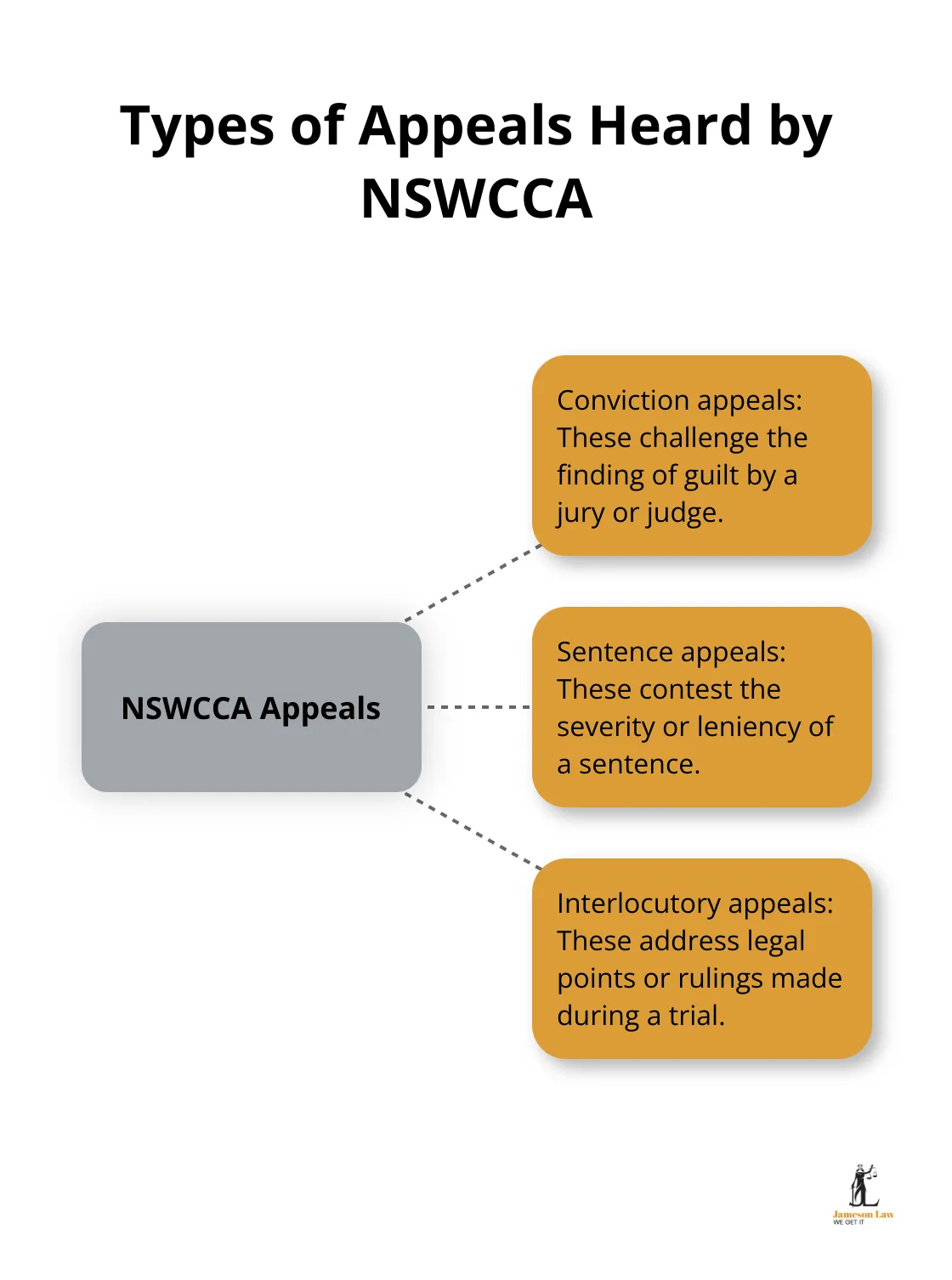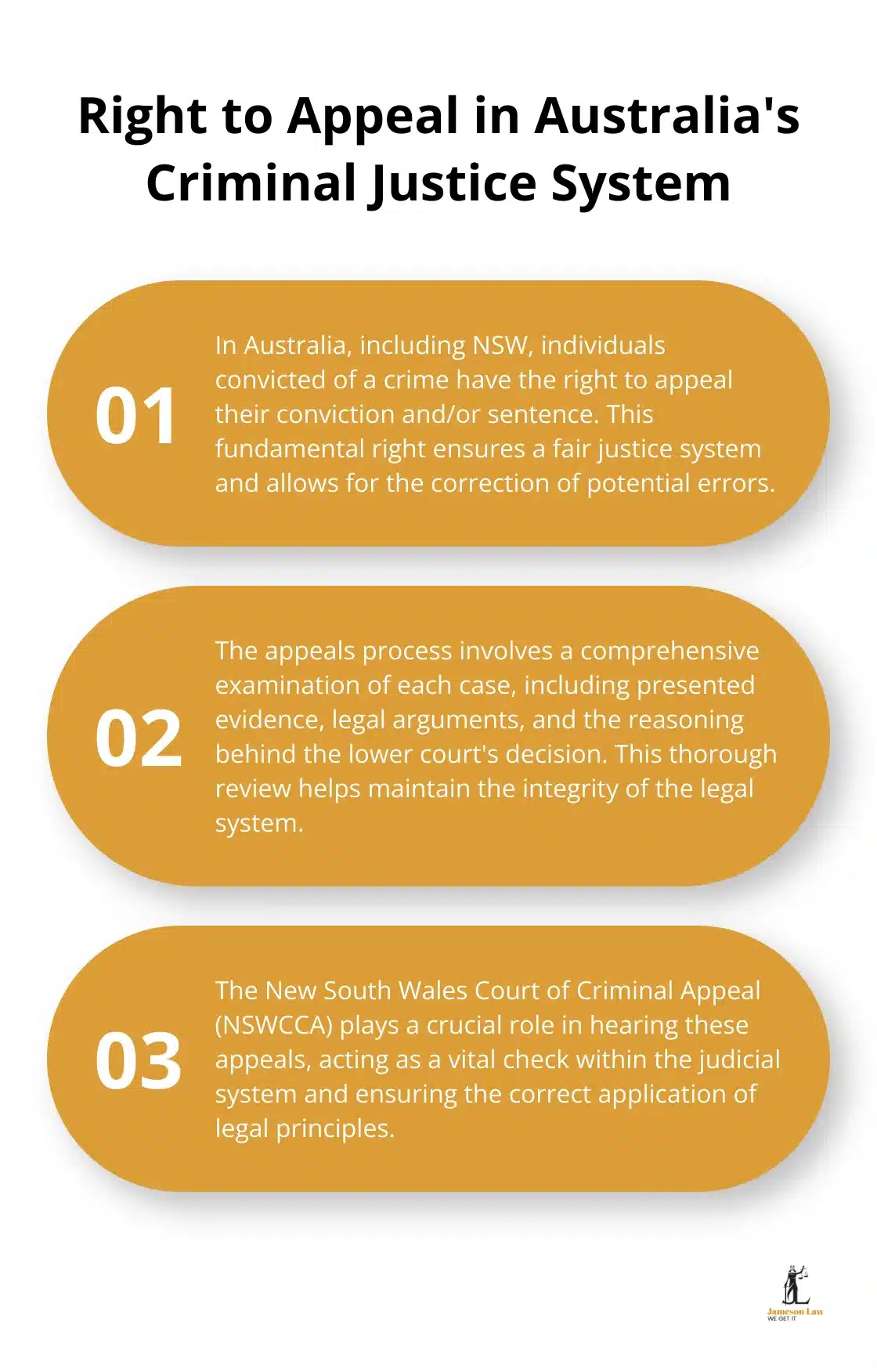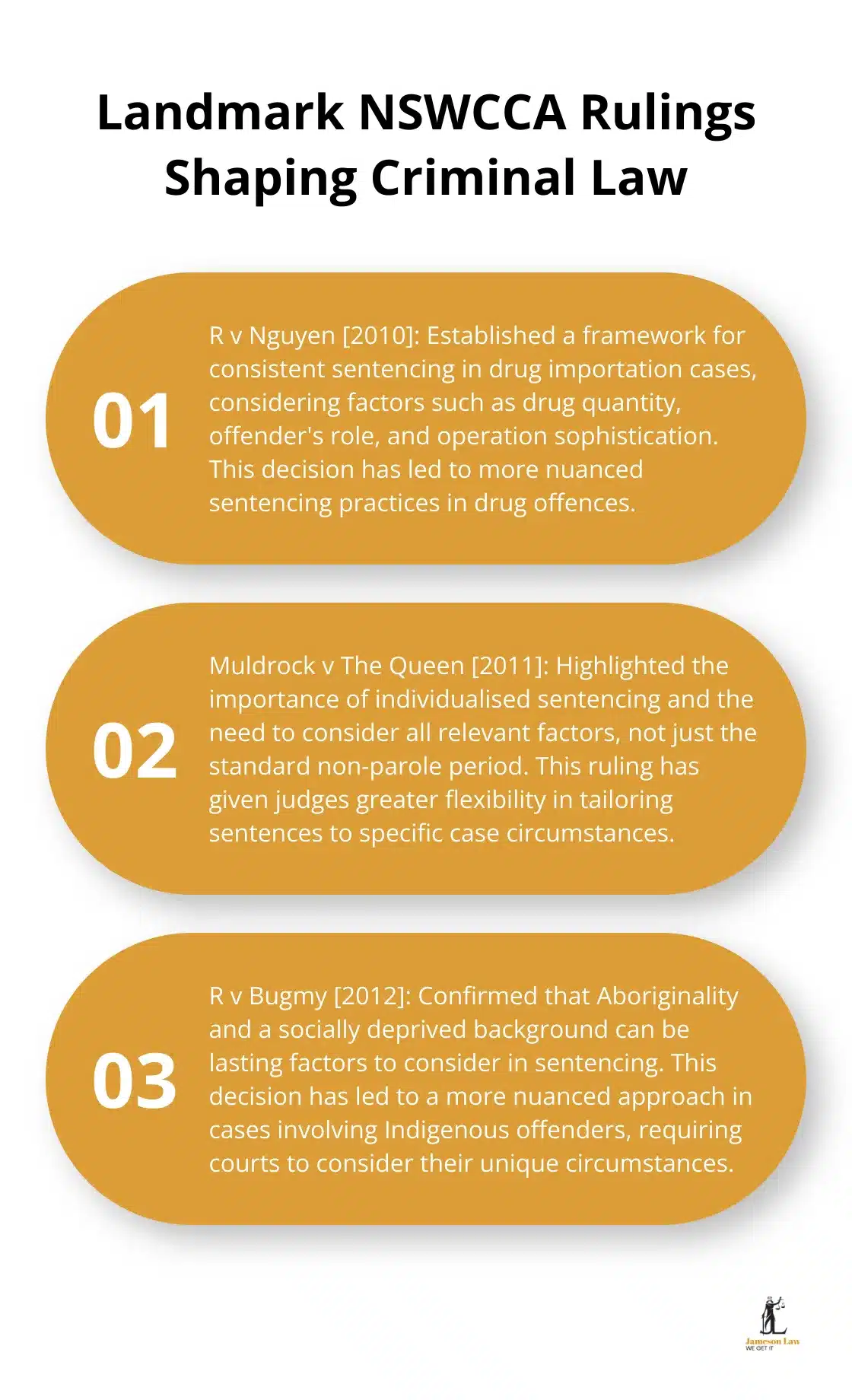The New South Wales Court of Criminal Appeal stands as a cornerstone of the State’s justice system. As the highest criminal court in NSW, it plays a vital role in shaping criminal law and ensuring fair legal proceedings.
At Jameson Law, we recognise the profound impact this court has on our clients and the broader legal landscape. This overview aims to shed light on the court’s structure, functions, and significant contributions to criminal justice in New South Wales.
How Does the NSW Court of Criminal Appeal Function?
Composition and Structure
The New South Wales Court of Criminal Appeal (NSWCCA) operates as a specialised division within the Supreme Court of NSW. Its primary role involves hearing appeals against convictions and sentences from the District Court and Supreme Court. The NSWCCA was established under the 1912 Act.
The NSWCCA typically consists of a panel of three judges, though in cases involving complex legal issues, five judges may preside. These judges come from the Supreme Court bench, which ensures a high level of expertise in criminal law matters. The Chief Justice of NSW heads the Court, with support from the President of the Court of Appeal and other justices.
Types of Appeals Heard
The NSWCCA hears three main types of appeals:

- Conviction appeals: These challenge the finding of guilt by a jury or judge.
- Sentence appeals: These contest the severity or leniency of a sentence.
- Interlocutory appeals: These address legal points or rulings made during a trial.
The Appeals Process
The appeals process in the NSWCCA follows a strict timeline and requires meticulous preparation. Appellants must file a Notice of Intention to Appeal within 28 days of their conviction or sentence. They then have 12 months to lodge a formal Notice of Appeal along with supporting documents.
The hearing involves oral arguments from both sides, with the judges often asking probing questions. After the hearing, the Court may deliver its judgement immediately or reserve it for a later date.
Impact of NSWCCA Decisions
The NSWCCA’s decisions can have far-reaching effects. For example, the Court’s rulings can significantly impact the interpretation of drug supply laws in NSW, demonstrating the Court’s role in shaping criminal law. The maximum penalty for certain drug offences is 3,500 penalty units and/or 20 years imprisonment.
Understanding the structure and jurisdiction of the NSWCCA proves essential for anyone involved in criminal proceedings in NSW. Its decisions not only affect individual cases but also set precedents that guide lower courts and shape the broader criminal justice landscape in the State.
The next section will explore the key functions and powers of the NSWCCA, further illustrating its importance in the NSW legal system.
What Powers Does the NSW Court of Criminal Appeal Have?
Reviewing Lower Court Decisions
The New South Wales Court of Criminal Appeal (NSWCCA) holds substantial authority in shaping the criminal justice landscape of NSW. Its powers extend beyond simple reviews of lower court decisions, encompassing criminal law interpretation and the establishment of binding precedents.
The NSWCCA’s primary function involves scrutiny of lower court decisions. This process acts as a vital check within the judicial system, ensuring justice and correct application of legal principles.
The Court’s review power involves a comprehensive examination of each case, including presented evidence, legal arguments, and the reasoning behind the lower court’s decision. In Australia, including NSW, individuals convicted of a crime have the right to appeal their conviction and/or sentence, illustrating the significant volume of cases that undergo this rigorous review process.

Interpreting Criminal Law
The NSWCCA plays a key role in interpreting and clarifying criminal law in NSW. This function becomes particularly important when new legislation is introduced or existing laws face challenges.
For example, in Muldrock v The Queen [2011] HCA 39, the High Court overturned the NSWCCA’s interpretation of standard non-parole periods. This led to a significant shift in sentencing practices across NSW (highlighting the far-reaching impact of the Court’s interpretative powers).
Setting Precedents for Lower Courts
The NSWCCA’s ability to set binding precedents stands as its most enduring power. These precedents guide lower courts in their decision-making processes, ensuring consistency and fairness across the NSW criminal justice system.
A notable example is R v Bugmy [2012] NSWCCA 223, where the High Court confirmed that Aboriginality and a socially deprived background can be lasting factors to consider in sentencing. Lower courts have since applied this decision in numerous cases, shaping sentencing practices throughout NSW.
Real-World Implications
The NSWCCA’s powers have real-world implications for individuals facing criminal charges in NSW. Understanding these powers proves essential for anyone navigating the criminal justice system, whether as a defendant, legal practitioner, or interested observer.
Legal professionals (including those at Jameson Law) leverage their understanding of the NSWCCA’s functions and powers to provide strategic advice and representation to clients. This expertise allows for anticipation of potential outcomes and crafting of effective legal strategies, aiming for the best possible results in criminal matters.
The NSWCCA’s decisions not only affect individual cases but also set precedents that guide lower courts and shape the broader criminal justice landscape in the State. The next section will explore some notable cases and decisions that have had a significant impact on NSW criminal law.
How Have NSWCCA Rulings Shaped Criminal Law?
The NSW Court of Criminal Appeal (NSWCCA) has made several landmark rulings that have profoundly influenced criminal law in NSW. These decisions have not only affected individual cases but have also set precedents that guide lower courts and shape legal practice across the State.
Groundbreaking Decisions in Drug Offences
The NSWCCA has had a significant impact on drug offences. In R v Nguyen [2010] NSWCCA 238, the Court used a schedule of cases containing importation sentences imposed by courts throughout the country. This decision has since applied to numerous cases, providing a framework for judges to ensure consistency in sentencing for these serious offences.
The Court’s ruling in R v Nguyen emphasised the need to consider factors such as the quantity of drugs, the role of the offender, and the level of sophistication of the operation. This decision has led to more nuanced sentencing practices, allowing for a fairer assessment of individual culpability in drug importation cases.

Reshaping Sentencing Practices
The NSWCCA has also played a key role in refining sentencing practices across various offences. In Muldrock v The Queen [2011] HCA 39, the Court of Criminal Appeal erred by treating the provision of the standard non-parole period as having determinative significance.
This decision highlighted the importance of individualised sentencing and the need to consider all relevant factors (not just the standard non-parole period). As a result, judges now have greater flexibility in tailoring sentences to the specific circumstances of each case, promoting fairer outcomes for defendants.
Influence on Legal Practice
The NSWCCA’s decisions have had far-reaching effects on legal practice in NSW. For instance, the Court’s ruling in R v Bugmy [2012] NSWCCA 223 confirmed that Aboriginality and a socially deprived background can be lasting factors to consider in sentencing. This decision has led to a more nuanced approach in cases involving Indigenous offenders, requiring courts to take into account the unique circumstances and challenges faced by these individuals.
Legal practitioners have had to adapt their strategies in light of these landmark rulings. Understanding the principles established by the NSWCCA is essential for effective representation and achieving the best possible outcomes for clients in criminal matters.
Ongoing Evolution of Criminal Law
The NSWCCA’s decisions continue to shape the landscape of criminal law in NSW. The Court’s rulings ensure that the justice system evolves to meet the changing needs of society while maintaining fairness and consistency in legal proceedings (a balance that requires constant vigilance and adaptation).
Final Thoughts
The New South Wales Court of Criminal Appeal plays a vital role in shaping criminal law and ensuring justice in the State’s legal system. Its decisions impact individual cases and set precedents that guide lower courts, influencing legal practice across NSW. The Court faces ongoing challenges from emerging technologies, changing social norms, and new forms of criminal activity, which it must address to maintain the integrity of the criminal justice system.
The NSWCCA must balance efficiency with thorough consideration of complex legal issues while adapting to societal changes. Its decisions affect the lives of individuals involved in cases and shape the broader legal landscape (ensuring consistency and fairness across all levels of the NSW justice system). Understanding the role and functions of the New South Wales Court of Criminal Appeal proves essential for those navigating the complexities of criminal law in NSW.
At Jameson Law, we use our expertise in criminal law to provide comprehensive legal support. We strive to offer our clients the best possible representation, taking into account the NSWCCA’s rulings and precedents. The Court’s ongoing commitment to justice, fairness, and legal clarity will continue to shape the criminal law landscape in NSW for years to come.













